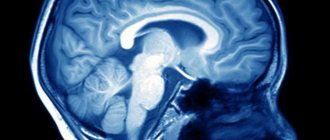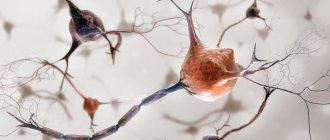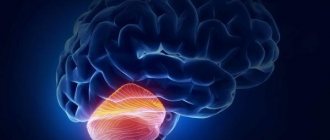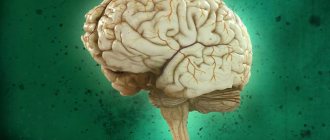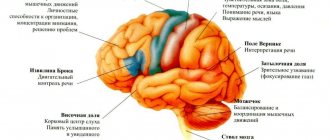Causes of cerebellar ataxia
In neurology, a classification of cerebellar ataxia is used, based on the criteria for the course of the disease. It distinguishes three main types of ataxia: acute onset, subacute onset and chronic. Each of these types can be caused by different diseases.
Ataxia with acute onset (develops suddenly after exposure to provoking factors on the body):
- ischemic stroke provoked by atherosclerotic occlusion or embolism of the cerebral arteries that feed the cerebellar tissue (considered one of the most common causes of pathology);
- hemorrhagic stroke;
- cerebellar injury resulting from intracerebral hematoma or traumatic brain injury;
- multiple sclerosis;
- Guillain-Barre syndrome;
- encephalitis and post-infectious cerebellitis;
- intoxication of the body (lithium, barbiturates, diphenine);
- hyperthermia;
- metabolic disorders;
- obstructive hydrocephalus.
Ataxia with subacute onset (develops over one or more weeks):
- tumors, various types of abscesses and other space-occupying processes in the cerebellum (astrocytoma, medulloblastoma, hemangioblastoma, ependymoma);
- normal pressure hydrocephalus caused by subarachnoid hemorrhage after brain surgery or meningitis;
- endocrine disorders (hyperparathyroidism, hypothyroidism);
- vitamin deficiency;
- overdose of anticonvulsants;
- toxic and metabolic disorders associated with absorption and nutritional disorders;
- malignant tumor diseases (lung cancer, ovarian cancer);
- paraneoplastic cerebellar degeneration.
Chronically progressive ataxia (develops over a couple of months or years):
- spinocerebellar ataxia (Friedreich's ataxia, "Nefriedreich's" ataxia);
- cortical cerebellar ataxias (Cortical cerebellar atrophy of Holmes, Late cerebellar atrophy of Marie-Foy-Alaguanine);
- late-onset cerebellar ataxias (OPCA, Machado-Joseph disease, cerebellar dysgenesis).
Causes of impaired coordination of movements in adults and children
Movement coordination disorder (MCD) is a disorder in the processes of coordinating muscle activity when performing motor tasks.
One form of NCD is ataxia. The condition is observed with damage to the cerebellum, frontal lobes, and pathways of proprioceptive (deep) sensitivity. The pathology manifests itself as a disorder of motor coordination (dynamic ataxia) or an imbalance in a standing position (static ataxia). Moderate dynamic ataxia is characterized by a lack of smoothness and precision of movements. With moderate static ataxia, the ability to maintain normal body position at rest is lost. Types of ataxia (depending on the location of the lesion):
- cerebellar – caused by cerebellar dysfunction;
- vestibular - manifests itself when the vestibular apparatus is damaged;
- sensitive – caused by loss of proprioception (sense of one’s own body) due to dysfunction of the dorsal horns of the spinal cord;
- cortical – occurs when there is dysfunction of the cortex of the anterior parts of the frontal lobe.
Hereditary ataxias are also divided into several types: Friedreich, Pierre-Marie, Louis-Bar syndrome and others.
Symptoms of cerebellar ataxia
Patients with cerebellar ataxia usually make swinging and unsteady movements when walking. Their gait is unsteady; for greater stability they try to spread their legs wide apart. If the patient is asked to try to walk along one line, he may be seen to sway from one side to the other. Typically, the symptoms of the disease become more pronounced when the patient suddenly changes direction of movement or gets up from a chair and immediately tries to walk quickly.
When walking, the following conditions are observed: hypometria (sudden stop of movement even before a certain goal has been achieved) and hypermetria (excessive range of motion). Patients with cerebellar ataxia are usually unable to perform contralateral movements quickly. Due to problems with coordination, a pathological change in handwriting occurs: macrography appears, it becomes sweeping and uneven.
Cerebellar pathology is also characterized by deviation when walking or even falling to one side. During an appointment with a neurologist, the patient performs a finger-nose test. Typically, patients experience not only waving a finger past the tip of the nose, but also a noticeable tremor of the hands. In this case, it does not matter at all whether the patient’s eyes are open or closed, since this does not affect the test results. Using this test, it is possible to distinguish cerebellar ataxia from vestibular and sensitive.
The following symptoms are characteristic of congenital types of cerebellar ataxia:
- impaired coordination of individual muscles;
- vertical instability;
- abruptness of speech;
- delayed speech and mental development;
- late onset of walking and sitting in children.
Cerebellar ataxia is often accompanied by dysarthria and nystagmus. It is impossible not to notice that the patient has problems with speech: it slows down, loses its smoothness, becomes intermittent and scanned. As the disease progresses, patients' handwriting becomes impaired, facial expressions become poor, lower back pain appears, convulsive twitching occurs, vision deteriorates, strabismus develops, difficulties with swallowing and eating in general arise, hearing is impaired, the psyche changes and depression occurs.
A characteristic sign of the disease, thanks to which it can be diagnosed, will be a violation of combined movements, which normally should go together. For example, when bending the body back, a person usually bends his legs at the knees, and when he tries to look up, throwing his head back, he wrinkles his forehead a little. In patients with ataxia, these movements are usually not coordinated.
1.General information
Neurodegeneration is a pathological process, with the development of which nervous tissue loses its complex organization, degenerates, gradually atrophies (decreases in volume and dies), becoming, in general, functionally untenable. Considering that the nervous system controls and regulates literally everything in the body, neurodegenerative diseases, even the slowest and most indolent ones, always constitute a serious problem, which is aggravated by the fact that at the moment all efforts to develop reparative (restorative) and etiopathogenetic ( eliminating the root cause of the disease) types of therapy have not brought tangible results.
For the most part, neurodegenerative diseases are caused by, or at least reliably associated with, hereditary, chromosomal factors. These diseases are traditionally considered rare, and in terms of tens and hundreds of thousands of people, many of them really seem to be sporadic, almost random anomalies. However, if we sum up the incidence of the fairly well-known diseases Alzheimer's, Pick's, Parkinson's, demyelinating multiple or amyotrophic lateral sclerosis, and DLB (dementia with Lewy bodies), the picture will look more alarming. Thus, with reference to data from post-mortem pathomorphological studies, it has been repeatedly emphasized in the literature that the same DLB (one of the frontotemporal variants of neurodegeneration) is diagnosed much less frequently than it actually occurs.
A large number of individual nosological units (i.e., officially established diagnoses of this group) are the subject of critical discussions, since degeneration of neural tissue is the main and common mechanism for the development of such diseases; for example, the extreme wing of supporters of generalization proposed “for convenience” to consider all diseases of this kind as only particular variants of Alzheimer’s or Parkinson’s diseases. This approach can hardly be considered justified: the clinical picture, rate of progression, prognosis, strategy of symptomatic treatment - all this is determined by a number of significant factors (primarily the predominant localization of the process) and differs sufficiently to speak of independent diseases.
The above fully applies to spinocerebellar ataxia. This is a hereditary neurodegenerative disease with its own distinct specificity, which can manifest at any age (usually in the range of 5-40 years) and is distinguished by a variety of forms: to date, over twenty relatively independent types have been identified and described (SCA, SCA 2, Friedreich's disease and many others). etc.).
A must read! Help with treatment and hospitalization!
Diagnosis of cerebellar ataxia
When diagnosing, the doctor must take into account that it can be caused by a variety of diseases. That is why such specialists as a neurologist, traumatologist, oncologist, endocrinologist, geneticist, and neurosurgeon participate in the diagnosis of pathology. The first stage of diagnosis is examination of the patient and collection of anamnesis. Patients with coordination problems usually complain of staggering and falling while walking.
To make an accurate diagnosis, the doctor asks the patient whether the symptoms of the pathology increase in the dark, and asks whether frequent dizziness bothers him. During the clinical examination, the neurologist evaluates the patient's gait and balance. For example, to test gait, a doctor may ask a patient to walk in a straight line and then make a turn.
The most reliable methods for making an accurate diagnosis for cerebellar ataxia are CT, MSCT and MRI of the brain. With their help, it is possible to detect brain tumors, congenital anomalies, and pathological changes in the cerebellum. For a more accurate diagnosis of pathology, Doppler sonography and MRA of brain vessels can also be used. Genetic analysis and DNA diagnostics allow identifying the disease in the case of its hereditary etiology.
The symptoms of cerebellar ataxia are in many ways similar to the symptoms of other neurological pathologies. Therefore, it is important for a neurologist to carry out the most accurate differential diagnosis. Namely, with the help of studies of the vestibular analyzer (vestibulometry, stabilography, electronystagmography) it is possible to exclude vestibular disorders. CSF hypertension, symptoms of hemorrhage, tumor or inflammatory processes can be detected by performing a lumbar puncture. You can exclude infectious damage to the brain by obtaining the results of a PCR test or a blood test for sterility.
Physical rehabilitation
Current research suggests that if a person is able to walk, physical rehabilitation should include an exercise program with the following components:
- static balance;
- dynamic balance;
- coordination of the trunk and limbs;
- prevention of contracture formation.
Once the doctor determines that the person is able to safely perform the exercises on their own, the patient is encouraged to exercise daily at home. Systematic implementation of a set of exercises contributes to further improvement of the condition. To prevent the risk of falling due to poor balance or poor coordination, patients are advised to use a cane or walker. Since ataxia can lead to severe disability and the need to use a wheelchair, in addition to treating ataxia, it is necessary to take measures to increase muscle strength and general endurance.
Read more about gymnastics and exercise therapy for hereditary ataxia in children on our website.
Related services: Physical therapy Consultation with a neurologist
Drug therapy
If the pathology was caused by an infectious-inflammatory process, then the doctor prescribes antiviral or antibacterial therapy. Vascular disorders that cause cerebellar ataxia are treated by stopping cerebral bleeding or normalizing blood circulation. For this, the patient is prescribed the following groups of drugs: thrombolytics, angioprotectors, antiplatelet agents, anticoagulants, vasodilators.
If cerebellar ataxia has a hereditary etiology, it is impossible to completely get rid of it. Basically, doctors resort to metabolic therapy, which involves prescribing drugs such as cerebrolysin, vitamins B12, B6 and B1, ATP, ginkgo biloba preparations, mildronate, piracetam. To increase the tone of skeletal muscles and improve metabolism in them, massage is recommended for patients.
Clinical picture
Uncertainty when walking appears from the onset of the disease, then the gait becomes unsteady. Weakness in the legs and stumbling appear 5–10 years after the onset of the disease. 20% of patients are concerned about numbness in the lower extremities, hearing loss, and speech impairment. Half of the patients experience discomfort in the heart area, possible interruptions in heart function, and shortness of breath during exercise.
An objective examination reveals mild paresis in the legs (40%), muscle hypotonia (70%), gradually developing atrophy of the muscles of the lower extremities (20%), decreased knee and Achilles reflexes (80%), hypoesthesia in the lower extremities (30%), violation of deep sensitivity (50%). Ataxia, dysdiadochokinesis, and intention tremor in the hands are noted (up to 100%). Large-scale nystagmus and scanned speech are observed in 75% of cases, head tremor in 30%, hypoacusis in 20%. Mild acrocyanosis (30%), skeletal abnormalities (kyphoscoliosis, cavus foot) (50–70%) are detected.
Conservative therapy
In addition to drug therapy and surgical operations, complex therapy of the disease involves the appointment of other conservative methods. According to indications, patients may be prescribed speech therapy, occupational therapy, physiotherapy, and physical therapy. The latter involves both performing sports exercises and repeatedly repeating various household skills to improve coordination of movements: turning pages, pouring liquids, buttoning clothes.
Incidence (per 100,000 people)
| Men | Women | |||||||||||||
| Age, years | 0-1 | 1-3 | 3-14 | 14-25 | 25-40 | 40-60 | 60 + | 0-1 | 1-3 | 3-14 | 14-25 | 25-40 | 40-60 | 60 + |
| Number of sick people | 1 | 2 | 5 | 7 | 7 | 7 | 7 | 1 | 2 | 5 | 7 | 7 | 7 | 7 |
Prognosis and prevention
The prognosis for the patient depends solely on the cause that triggered the onset of the disease. Acute and subacute ataxia caused by intoxication of the body, vascular disorders, and inflammatory processes can completely regress or partially persist. In this case, the prognosis for the patient will be as favorable as possible if the provoking factor can be eliminated in time: infection, toxic effects, vascular occlusion.
The chronic form of ataxia is characterized by a gradual increase in symptoms, which ultimately leads to disability of the patient. The greatest danger to the patient's life is cerebellar ataxia caused by tumor processes. The rapid development of the disease and disruption of the functioning of many organs leads to serious complications that significantly worsen the patient’s quality of life.
Prevention of cerebellar ataxia involves preventing traumatic brain injury, infection of the body, the development of vascular disorders, timely treatment of chronic cerebral ischemia, compensation for metabolic and endocrine disorders, and mandatory genetic counseling during pregnancy planning.
3. Symptoms, diagnosis
The probable symptoms of spinocerebellar neuronal degeneration are so polymorphic that it is impossible to describe at least the main of its twenty types in one article. There are disorders of visual-motor coordination and muscle tone (tremor, extrapyramidal “stiffness”); partial paralysis of the extraocular muscles and degenerative retinopathy in combination with optic nerve atrophy; general atrophy of muscle fibers; various neurological symptom complexes. If the neurodegenerative process affects the cerebral cortex, dementia gradually develops - a debilitating decline in cognitive functions (memory, attention, various types of recognition, etc.), logical thinking, and speech organization. In case of damage to the medulla oblongata, “bulbar” symptoms develop: degradation of swallowing, palatal, chewing, and respiratory reflexes.
Diseases in this group progress relatively slowly: the course can take up to 20 years or more, although much faster developments have also been described. Patients gradually lose the ability for self-care and, in general, for productive contact with the world; they increasingly depend on the care and support of others, falling into complete helplessness towards the terminal stage and dying, as a rule, from pneumonia, exhaustion, respiratory failure, etc.
Neurodegenerative diseases, including ataxia, are diagnosed clinically, during a neurological examination and a thorough analysis of complaints and anamnestic information. Additionally, tomographic imaging methods, neuropsychological examination, etc. may be prescribed, but the final diagnosis is established and differentiated, as a rule, only pathomorphologically.
About our clinic Chistye Prudy metro station Medintercom page!
Advantages of F. Belgau's method
The cerebellar stimulation program uses a systematic approach to correcting disorders: on the one hand, cerebellar stimulation, on the other, sensory integration, taking into account the basic principles of pediatric neuropsychology. It is believed that the vestibular systems of the brain play a decisive role in any activity: they help coordinate not only gross, but also fine motor skills, and establish connections between all the main organs and parts of the brain that are involved in writing, reading, and counting. The vestibular apparatus is the main connecting link of the brain.
F. Belgau's method is effective in working with children aged 4 years and older. Children enjoy practicing on the Belgau balance board (Balametrix). Classes are held in a playful way and are somewhat reminiscent of physical therapy, only more interesting and do not evoke negative emotions or fear of failure in children.
The cerebellar stimulation program has a wide range of applications in the correction of various disorders, promotes the normalization of brain function and development, and has few contraindications.
The program presents original and varied exercises that vary in level of complexity and focus, i.e. There is a gradual formation and development of various skills individually in each case.
It has been proven that cerebellar stimulation increases the effectiveness of other correctional sessions with a speech pathologist, speech therapist or psychologist. According to Belgau himself, after just 15 minutes of classes, you will be able to observe more competent and clear writing, greater composure, improved memory and counting.
The results of long-term application of the method allowed the program to be called advanced in working with a whole range of learning problems.

